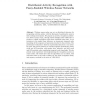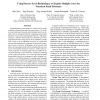520 search results - page 62 / 104 » Computing recombination networks from binary sequences |
199
click to vote
Publication
he significant increase in the available computational power that took place in recent decades has been accompanied by a growing interest in the application of the evolutionary ap...
PERCOM
2008
ACM
15 years 6 months ago
2008
ACM
Mass causality incidents generate a sequence of response events from the emergency services, requiring the allocation and use of resources in a timely fashion. In this paper we de...
111
click to vote
DCOSS
2008
Springer
15 years 1 months ago
2008
Springer
Wireless sensor nodes can act as distributed detectors for recognizing activities online, with the final goal of assisting the users in their working environment. We propose an act...
ICML
2006
IEEE
16 years 20 days ago
2006
IEEE
Knowledge-based planning methods offer benefits over classical techniques, but they are time consuming and costly to construct. There has been research on learning plan knowledge ...
114
click to vote
DSN
2007
IEEE
15 years 6 months ago
2007
IEEE
Transient faults are emerging as a critical concern in the reliability of general-purpose microprocessors. As architectural trends point towards multi-threaded multi-core designs,...


